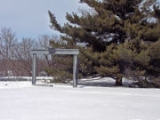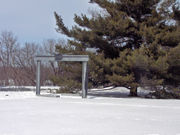
Monument to Canadian Aid Workers
Encyclopedia
The Monument to Canadian Aid Workers (French: Monument commémoratif de l'aide humanitaire canadienne) is a monument in the Canadian
city of Ottawa
dedicated to Canadian aid workers who have lost their lives during foreign deployments. As a monument, it is internationally unique in its form and purpose.
on the Comoros Islands. Three weeks later 51-year-old nurse Nancy Malloy of the Canadian Red Cross
and working with the International Committee of the Red Cross
died in a field hospital
in the Chechen
city Novye Atagi
near Grozny
. She was murdered in her sleep along with five other colleagues by unknown assailants.
The organization PATH Canada, the Canadian Red Cross
, and the Canadian Nurses Association
sought a way to remember their service and began a project to realize a monument in their and other fallen aid workers' honor. The monument itself was dedicated four years later on June 28, 2001.
 The monument is located in Rideau Falls Park in Ottawa. It consists of a rectangular bronze
The monument is located in Rideau Falls Park in Ottawa. It consists of a rectangular bronze
arch with two bronze
feathers, one on the top and the other at the side of the arch, all standing on a granite
platform. There are also two granite benches where visitors can sit. The height of the monument is 3.35 metres with a base area of 4.27 x 4.88 metres.
The design was created by John Greer
from Halifax
, Nova Scotia
who won the monument's national design competition in May 1999. His design was entitled "Reflection" which also became the name of the monument. The project was financed by a private fundraising effort and an approximately $75,000 investment by the Canadian International Development Agency
.
The monument has three key messages. First, it is intended to appreciate Canada's long-standing activities in international development
and humanitarian assistance
; second, it honors all Canadians who died while serving in these fields abroad; third, it pays a personal tribute to Nancy Malloy and Tim Stone. Part of the project was to create a permanent list of all Canadian aid workers who have lost their lives in foreign deployments. The list currently holds 88 individuals, marking their names and dates of birth and death.
Canada
Canada is a North American country consisting of ten provinces and three territories. Located in the northern part of the continent, it extends from the Atlantic Ocean in the east to the Pacific Ocean in the west, and northward into the Arctic Ocean...
city of Ottawa
Ottawa
Ottawa is the capital of Canada, the second largest city in the Province of Ontario, and the fourth largest city in the country. The city is located on the south bank of the Ottawa River in the eastern portion of Southern Ontario...
dedicated to Canadian aid workers who have lost their lives during foreign deployments. As a monument, it is internationally unique in its form and purpose.
Impulse behind its erection
In 1996 two Canadian aid workers were killed in a short period in different incidents. Tim Stone, the executive director of the organization PATH Canada (Programme for Appropriate Technology in Health) died in the crash of hijacked Ethiopian Airlines Flight 961Ethiopian Airlines Flight 961
Ethiopian Airlines Flight 961, a Boeing 767-260ER, was hijacked on , en route from Addis Ababa to Nairobi on a Bombay–Addis Ababa–Nairobi–Brazzaville–Lagos–Abidjan service, by three Ethiopians seeking political asylum in Australia. The plane crash-landed in the Indian Ocean near Comoros due to fuel...
on the Comoros Islands. Three weeks later 51-year-old nurse Nancy Malloy of the Canadian Red Cross
Canadian Red Cross
The Canadian Red Cross Society is a Canadian humanitarian charitable organization and one of 186 national Red Cross and Red Crescent societies....
and working with the International Committee of the Red Cross
International Committee of the Red Cross
The International Committee of the Red Cross is a private humanitarian institution based in Geneva, Switzerland. States parties to the four Geneva Conventions of 1949 and their Additional Protocols of 1977 and 2005, have given the ICRC a mandate to protect the victims of international and...
died in a field hospital
The ICRC hospital of Novye Atagi
The ICRC Hospital of Novye Atagi is an International Committee of the Red Cross hospital in Novye Atagi, Chechnya, Russian Federation. It was evacuated in December 1996 when six members of the expatriate team were assassinated during an early morning raid by an unidentified armed group...
in the Chechen
Chechnya
The Chechen Republic , commonly referred to as Chechnya , also spelled Chechnia or Chechenia, sometimes referred to as Ichkeria , is a federal subject of Russia . It is located in the southeastern part of Europe in the Northern Caucasus mountains. The capital of the republic is the city of Grozny...
city Novye Atagi
Novye Atagi
Novye Atagi is a village in Shalinsky District of the Chechen Republic, Russia, located twenty kilometres south of Grozny. Population: 8,741 .-External links:**...
near Grozny
Grozny
Grozny is the capital city of the Chechen Republic, Russia. The city lies on the Sunzha River. According to the preliminary results of the 2010 Census, the city had a population of 271,596; up from 210,720 recorded in the 2002 Census. but still only about two-thirds of 399,688 recorded in the 1989...
. She was murdered in her sleep along with five other colleagues by unknown assailants.
The organization PATH Canada, the Canadian Red Cross
Canadian Red Cross
The Canadian Red Cross Society is a Canadian humanitarian charitable organization and one of 186 national Red Cross and Red Crescent societies....
, and the Canadian Nurses Association
Canadian Nurses Association
The Canadian Nurses Association is a federation of 11 provincial and territorial registered nurses associations representing more than 139,893 Canadian registered nurses and nurse practitioners...
sought a way to remember their service and began a project to realize a monument in their and other fallen aid workers' honor. The monument itself was dedicated four years later on June 28, 2001.
Monument

Bronze
Bronze is a metal alloy consisting primarily of copper, usually with tin as the main additive. It is hard and brittle, and it was particularly significant in antiquity, so much so that the Bronze Age was named after the metal...
arch with two bronze
Bronze
Bronze is a metal alloy consisting primarily of copper, usually with tin as the main additive. It is hard and brittle, and it was particularly significant in antiquity, so much so that the Bronze Age was named after the metal...
feathers, one on the top and the other at the side of the arch, all standing on a granite
Granite
Granite is a common and widely occurring type of intrusive, felsic, igneous rock. Granite usually has a medium- to coarse-grained texture. Occasionally some individual crystals are larger than the groundmass, in which case the texture is known as porphyritic. A granitic rock with a porphyritic...
platform. There are also two granite benches where visitors can sit. The height of the monument is 3.35 metres with a base area of 4.27 x 4.88 metres.
The design was created by John Greer
John Greer
John Greer is a Canadian sculptor.Greer has exhibited his work since 1967 extensively in Canada and the USA, Iceland and Korea. Greer studied Fine Art from 1962–1967 in Halifax, Montreal and Vancouver. He taught sculpture at NSCAD University in Halifax for 26 years and is based in LaHave, Nova...
from Halifax
Halifax Regional Municipality, Nova Scotia
Halifax Regional Municipality is the capital of the province of Nova Scotia, Canada. The Regional Municipality had a 2006 census population of 372,679, while the metropolitan area had a 2010 estimated population of 403,188, and the urban area of Halifax had a population of 282,924...
, Nova Scotia
Nova Scotia
Nova Scotia is one of Canada's three Maritime provinces and is the most populous province in Atlantic Canada. The name of the province is Latin for "New Scotland," but "Nova Scotia" is the recognized, English-language name of the province. The provincial capital is Halifax. Nova Scotia is the...
who won the monument's national design competition in May 1999. His design was entitled "Reflection" which also became the name of the monument. The project was financed by a private fundraising effort and an approximately $75,000 investment by the Canadian International Development Agency
Canadian International Development Agency
The Canadian International Development Agency was formed in 1968 by the Canadian government. CIDA administers foreign aid programs in developing countries, and operates in partnership with other Canadian organizations in the public and private sectors as well as other international organizations...
.
The monument has three key messages. First, it is intended to appreciate Canada's long-standing activities in international development
International development
International development or global development is a concept that lacks a universally accepted definition, but it is most used in a holistic and multi-disciplinary context of human development — the development of greater quality of life for humans...
and humanitarian assistance
Humanitarian aid
Humanitarian aid is material or logistical assistance provided for humanitarian purposes, typically in response to humanitarian crises including natural disaster and man-made disaster. The primary objective of humanitarian aid is to save lives, alleviate suffering, and maintain human dignity...
; second, it honors all Canadians who died while serving in these fields abroad; third, it pays a personal tribute to Nancy Malloy and Tim Stone. Part of the project was to create a permanent list of all Canadian aid workers who have lost their lives in foreign deployments. The list currently holds 88 individuals, marking their names and dates of birth and death.
External links
- HealthBridge - Monument to Canadian Aid Workers
- Canadian Red Cross - Monument to Aid Workers
- HealthBridge - Lost Canadian Aid Workers Permanent Record
- John Greer, Sculptor Website of the designer with information and pictures

